Selected CRESP II Reports, Reviews and Presentations 2000 - 2006
CRESP II FINAL REPORT:
A Summary of Work
2000 - 2006
CRESP Grant Period: September 29, 2000 - September 29, 2006
Instrument No. DE - FG26-00NT 40938 (Original Instrument No. DE-FG01-03EW15336) Submitted by Charles W. Powers, PI CRESP II
View Report
Legal and Related
Policy Issues for Integrating Remediation and NRD Strategies at DOE Sites
View Report
Natural Resource Damages
and the Department of Energy: Integrating Ecosystem Recovery into the
Remediation Process
View Report
Natural Resource Damage
Assessments as Related to Department of Energy Site Clean up Concerns:
A Preliminary Review
View Report
Community Health Assurance
Monitoring Program
(CHAMP)
Radionuclide Biomonitoring Tests
National Expert Perspectives September 21, 2006
View Report |
End State Land Uses,
Sustainable Protective Systems, and Risk Management: A Challenge for Multi-Generational
Stewards
View Report
Land Use
Controls, Public Health Surveillance, and the Public’s Peace of Mind
at the United States Major Nuclear Weapons Legacy Sites
View Report
Environmental Cleanup of the Nation’s Former Nuclear Weapons Sites:Unprecedented Public-Private Challenges at the Largest Facilities
View Report
CommunityHealth Assurance Monitoring Program - CHAMP Technical and Feasibility Assessment of CHAMP as part of a
Sustainable Long-term Stewardship Vision, October 25, 2005
View Report |
CRESP Review of Pilot Studies in Support of Steam Reforming Processes for treating Sodium-Bearing Wastes (SBW) at the Idaho National Laboratory View Letter Report 1, Final Follow-up letter October 2006
Preliminary Risk Evaluation of
Calcined High-Level Waste Disposition at the Idaho Site
Full
Report (Idaho
National Laboratory Site Environmental Management Citizens Advisory
Board
Review
of CRESP Report
Recommendation #
123)
Preliminary Risk Evaluation of Options For
Buried Waste Disposition at the Idaho Site
Full
Report (Idaho National
Laboratory Site Environmental Management Citizens Advisory Board Review of CRESP Report Recommendation
# 124) |

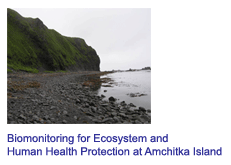
The purpose
of the biomonitoring report is to provide CRESP's recommendations for
a biomonitoring plan at Amchitka, particularly with respect to what radionuclides
to examine, what species should serve as
bioindicators, where to monitor, and when to monitor. The CRESP conclusions
are based on the data presented in the full
CRESP report (Powers et al. 2005) and addendum (Powers et al. 2006). This report was reviewed by the CRESP Peer Review
Committee.
View
Biomonitoring Report
View Peer Review Committee
Report
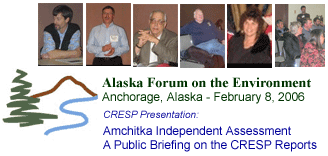
CRESP was
asked by the Alaska Department of Environmental Conservation (ADEC) to
present the results of its work on Amchitka to the Amchitka Nuclear Test
Sites Update session of the 2006 Alaska Forum on the Environment held
in Anchorage on February 8, 2006. This presentation provides the single
best graphic summary of CRESP's total Amchitka work product and its implications.
View Presentation (Large file size 7.93MB)
Photographs (Large file size 7.93MB)
Photographs
After the CRESP Presentation, John Halverson, ADEC Environmental Program
Manager and the Department's Amchitka lead, described the progress made
to date in converting this work into a process for designing a long-term
surveillance and maintenance (LTSM) program. Ray Plieness, Director of
the Land and Site Management Office of DOE's Office of Legacy Management,
described the work of his office and how it would work with Alaskans to
implement and sustain the LTSM.

On August
1 2005 CRESP, an independent consortium of university-based environmental
scientists, announced the results from three 2004 expeditions to Amchitka
Island in the western Aleutians to assess radionuclides in that marine
environment. Three nuclear test shots were set off under Amchitka by the
U.S. Government during a six-year period beginning in 1965.
View
Complete Report
Addendum
to Final Amchitka Report:
Additional Radiological Data for Bioindicator Selection
In this
addendum we report on the following additional analyses performed by CRESP
after preparation of the Report (July 2005): 1) Additional actinide analyses
of Ulva and kelp (including Laminaria), 2) Actinide analyses for additional
Rock Jingles, Blue Mussels and Horse Mussels, and 3) Cesium-137, Co-60
and I-129 analyses of additional fish (Atka Mackerel, Rock Sole, Ocean
Perch, Rock Greenling). These analyses were performed to aid in discrimination
for bioindicator selection and provide additional clarification of differences
in radionuclide content measured at Amchitka in comparison to Kiska. The
overall conclusion of the Amchitka Independent Science Assessment: Biological
and Geophysical Aspects of Potential Radionuclide Exposure in the Amchitka
Marine Environment remains the same: 1) the foods tested are safe to eat,
with radionuclide levels below published human health guidance levels,
2) our data do not suggest that radionuclides in biota collected from
Amchitka are attributable to the Amchitka test shots, and 3) a combination
of sedentary and mobile organisms at different trophic levels is ideal
for a continued biomonitoring program at Amchitka. The addendum was reviewed
by the CRESP Peer Review Committee. (View
Committee report) View
Addendum to Final Amchitka Report
AMCHITKA RADIONUCLIDE DATA SET
CRESP
is pleased to make available the raw analytic results for radionuclides
in biota from its Independent Scientific Assessment of the Amchitka marine
environment, including the reference site at Kiska Island. View
Data Set
and Note on
wet to dry weight conversions. (GPS Locations)
 CRESP
Answers to Questions from Stakeholders CRESP
Answers to Questions from Stakeholders
CRESP
held public meetings in Anchorage, Alaska to present the results of its
Amchitka independent assessment study on the evening of August 1 and the
morning of August 2, 2005. The CRESP presentation was followed that evening
by an hour and a half of questions from participants; and, as planned,
a second and more informal open session for additional questions was held
for about four hours the next morning.
About
70 persons including members of the press attended one or the other of
these meetings. For those who could not attend the meetings, we provide
some of the key
questions CRESP was asked and the answers provided in these meetings.

Briefing
on CRESP Amchitka Report August 1, 2005 View
Presentation; Meeting
Photos
CRESP
Press Release: Amchitka Assessment Results (August 1, 2005)
Press Coverage: Anchorage Daily News,
EurekAlert!,
The
Washington Times
Peer
Review of the Amchitka Report
Before releasing the report, CRESP did, as it typically does with important
studies, ask its distinguished peer review committee to review its draft
report so it could improve the final version. Arthur Upton, former director
of the National Cancer Institute and chair of the CRESP Review Committee
on behalf of its sub-committee (John F. Ahearne, Melvin W. Carter, Charles
Fairhurst, Ph.D., Morton Lippmann) on Amchitka said of that draft: "The
methods were well conceived, expertly applied and have produced results
that are definitive and thereby enable conclusions that should be meaningful
to all concerned…. In view of the high quality of the studies reported,
and their failure to find evidence of the release of radioactivity from
the shot
cavities into the surrounding environment, the results that are presented
should be reassuring to concerned stakeholders."
View
Peer Review Committee Report

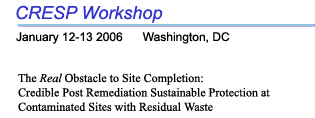
A day
and a half workshop, for federal agencies with regulatory, stewardship
and similar responsibilities for sites where radiological and other contamination
requires sustained management when active remedial activities have been
completed.
The purpose
was to promote active informal discussion and review among these federal
entities of the policies and guidance currently in place and being developed
for this complex of issues. The discussion was convened by, and informed
by work produced by the Consortium for Risk Evaluation with Stakeholder
Participation (CRESP) and participating agencies.The workshop included
a packet of background readings from EPA, NRC, DOE and CRESP. Agenda,
Presentations and Background Readings
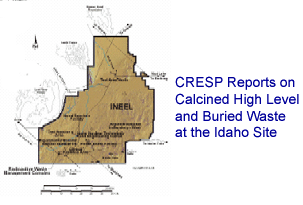

CRESP
was asked by DOE to carry out an independent evaluation of the risk
characterization for several alternatives for management of the
calcined HLW. This report is the result of review by CRESP of three
alternatives specified by the Department of Energy for the disposition
of the calcined HLW as part of a process to facilitate risk-informed
decision making.
 Full
Report // Full
Report //  Report
without appendices // Report
without appendices //  Appendices
Only Appendices
Only
Idaho
National Laboratory Site Environmental Management Citizens Advisory
Board
Review of Review
of Report Recommendation #
123

The
objective of this report is to develop a framework for the comparative
life-cycle risk evaluation of management options for ultimate disposition
of the wastes buried in the SDA. Remedial approaches may be implemented
either individually or in combination to achieve the desired remedial
objectives. In this context, it is essential to decide which combinations
of activities are appropriate for the subsections of the SDA or
contaminants present based on the characteristics of the buried
wastes and other factors. Developing a risk-informed decision that
considers human health and ecological risks along with other social
factors should include explicit consideration of the trade-offs
between reductions in human health risk achieved through each remediation
option and the additional human health risks incurred as part of
achieving that option. Thus, human health risk evaluation should
include consideration of risks to remediation workers and other
on-site and off-site populations for current and future generations.
This evaluation should also consider the context of nearby waste
management closure and remediation needs remaining risks and long-term
stewardship needs at the SDA. Integrated evaluation of this range
of human health risks often is not achieved as part of the remedial
decision process. This report provides a framework and preliminary
evaluation to achieve such integration.
 Full
Report Full
Report
Idaho National
Laboratory Site Environmental Management Citizens Advisory Board
Review of Review
of Report Recommendation
# 124
CRESP Letter to the
INEEL Citizens Advisory Board  View
Letter View
Letter |
CRESP
Symposium: New
Challenges and Approaches for Assessing Risk at Radioactive Sites
The
Society for Risk Analysis Annual Meeting 2004 Presentations:
Risk
in Complex Environments: Whence & Whither in a Continuing Struggle
Better to Relate
Risk Evaluation to the Cleanup of Radioactive Sites View presentation
View presentation
A Framework for Endstate Planning for the Impacts of Contamination and
Cleanup on Ecological Receptors  View
presentation View
presentation
Improving Public-Private Contracts for Managing Risks  View
presentation View
presentation
Risk in TechnicallySevere
Environments: Contaminant Isolation Facilities  View
presentation View
presentation
CRESP II: Helping to Rethink
the Path Forward to Long-Term Environmental Protection
- Incorporating
Risk in DOE’s Cleanup Decisions
past, present and future
by Charles
W. Powers, Ph.D and PI CRESP II
A Presentation
to the Committee on Risk-Based Approaches for Disposition of TRU and HL
Radioactive Wastes, NRC’s Board on Radioactive Waste Management in
Augusta, Georgia, January 28, 2004
 View presentation View presentation
A presentation
given by Charles
W. Powers, Ph.D. and PI CRESP IIin Richland, Washington March 10, 2004. View presentation View presentation
Reports and Presentations
A
Literature Guide Supporting the Planning and Implementation
of a Risk-based End State Program:
A Report prepared for the Department of Energy by CRESP
II
This
guide is intended to present the reader with a set of quality peer reviewed
literature that will aid the readers' understanding of human and ecological
risk involved in DOE's cleanup efforts in "achieving clearly defined,
risk-based end states" as stated in the EM's Cleanup Driven by Risk
Based End States Policy. As an aid in understanding the material in the
report CRESP has developed a course where a series of discussions will
be held that will explore key concepts in RBES.
Learn
more about the Report and Course
 View
report View
report
The
Roles for Risk in DOE Cleanup
A
Presentation given at the National Govenors Assciation and National Association
of Attorneys General Meeting November
10, 2002
by Charles W. Powers,
PI CRESP II  View presentation View presentation
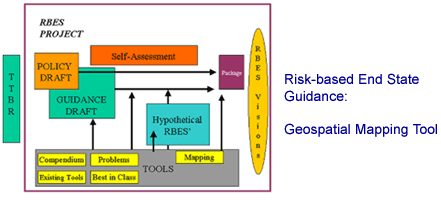
CRESP was
asked to design a core set of geospatial maps that can be developed and
used by all of the Department of Energy's former nuclear weapons sites.
Their purpose would be to effectively communicate the end-state vision
for each site that is being developed through the Risk-Based End State
(RBES) project, to regulators, DOE-HQ, and other important stakeholders.
These core maps would also permit a comparison between that end-state
vision and the site's current environmental and physical condition, with
a focus on the existing on and off-site risks to human and ecological
receptors.
 View report from the Social and Economic Impact and Public Policy Center
of Expertise View report from the Social and Economic Impact and Public Policy Center
of Expertise
THE
ROLE OF RISK AND FUTURE LAND USE IN CLEANUP AT THE DEPARTMENT OF ENERGY
As a result
of the Legacy of the Cold War, several governmental agencies are involved
in massive cleanup and remediation projects. In this paper we examine
the role of risk and future land use designations in cleanup at the Department
of Energy, using a self-assessment of 36 sites. We then discuss the tools
that might be required to address the cleanup challenge. Much of the current
cleanup program is driven by compliance with federal and state statutes
and regulations, presumably to protect human health and the environment.
Compliance, however, is not synonymous with cleanup. Although some of
these laws and regulations take risk into account, the lack of site-specific
data on exposures and risk scenarios, and the lack of attention to future
land use or endstates has potentially resulted in a disconnect between
risk and cleanup, risk and final endstates, and the cleanup levels and
endstate or subsequent land use. Partly this disconnect results from the
need for a range of technical, economic, sociological and public policy
tools to address the issues.
A better
transfer of information among and within Department of Energy facilities
and operations offices is required. Further, making decisions with the
final endstate in mind involves a number of risk tradeoffs, including:
-
ecological and
human health,
-
worker and public
health,
-
among competing
contaminated areas,
-
among temporal
patterns of cleanup,
-
among species
(plants vs animals, one animal vs another, and
-
among the sites
across the complex.
Such risk balancing
is required within sites and among Department of Energy sites, and perhaps,
among other remediation sites (such as those of Department of Defense
or Superfund sites).
 View
report View
report
CRESP Responds
to DOE Request for Review
In
2000 at the request of the manager of the Savannah River Site (SRS) CRESP
reviewed the risk prioritization process as it shapes the SRS integrated
priority list. CRESP experience over the last 5 years in the areas of
public health and safety, environmental protection, worker health and
safety, cost effectiveness, and public and community relations contributed
to the report.
The
Risk Prioritization Process as it Shapes the SRS Integrated Priority List:
An Initial Review of the Savannah River Site Model (2000) View Full Report
CRESP Peer
Review Committee Report
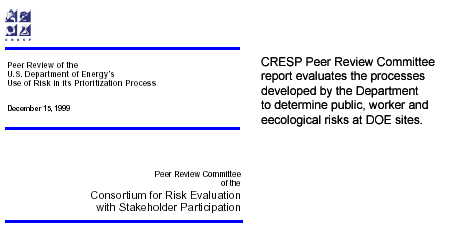
View the report
Social
Economic and Impact Center Report:
Policy Options for Contributing to Regional Economic Stability at USDOE
Facilities
Drawing
from studies on US DOE facilities, this CRESP Researcher Report focuses
on key policy-related issues and options that would help the most economically
distressed regions facing cutbacks in DOE employment to achieve smart
decline with less pain and ultimately a more stable economy.
Two questions
of concern to many stakeholders in communities near major DOE sites are:
1. How
has DOE presence affected the areas surrounding the sites? What do theory,
history and likely future trends tell us about the economic health of
these DOE-site-centered regions?
2. What can be done by the Federal government to help these site-regions
establish more sustainable and less volatile economies?
 View
report from the Social and Economic Impact Center of Expertise View
report from the Social and Economic Impact Center of Expertise
Defining
background groundwater quality
at the Savannah River Site
The Savannah River
Site (SRS) was established in the 1950s as a U.S. Department of Energy
installation for the production of strategically important nuclear materials.
During the course of operations, hazardous and radioactive wastes in solid
and liquid forms have been generated and disposed of on-site. As a result
of these activities, constituents of potential concern (COPCS) have migrated
into groundwater underlying the site. However, elevated concentrations
of COPCs also may be a consequence of natural occurrence in geologic materials
in the vadose zone or aquifer sediments, or land use practices prior to
the formation of SRS. Furthermore, practical implementation of site remediation
and environmental monitoring activities requires distinction of contamination
that is attributable to defined localized sources in contrast to diffuse
contamination that cannot be attributed to distinct natural or anthropogenic
sources. The objective of the work presented in this report was to formulate
approaches for defining background or baseline levels of seventeen COPCs
in groundwater.
View
report from the Exposure Assessment Center of Expertise
Defining
Background Groundwater Quality at the Savannah River Site
(V.M. Vyas, A. Roy, W. Strawderman, P.G. Georgopoulos, D.S. Kosson)
Large file - may take a long time to download.
Try it in three parts: Part
1 | Part
2 | Part
3 
More
information on the Exposure Assessment Center of Expertise
Modeling Forest
Fires at or Near Nuclear and Hazardous Waste Sites of DOE
CRESP research is relevant to many timely
issues such as the recent fires at Los Alamos. CRESP Exposure Assessment
Center reports include:
-
Numerical Modeling of Forest Fires with
a 3-D Meteorological/Dispersion Model
-
Investigations of the Effects of Forest
Fires on the Atmosphere using a coupled Forest-Fire/Meteorology- Dispersion
Model
-
Modeling the Impact of Forest Fires on
the Emission and Atmospheric Transport of Contaminants
A new CRESP research report "A Coupled Forest
Fire Emission and Atmospheric Dispersion Model: Application to the Savannah
River Site (SRS)" is available in full
text. 
Can Science
Really Foster
Better Public Policy Decisions?
The Lessons
of the CRESP Experience
How and why science from CRESP
is being used directly to impact decisions that improve regulatory response
and the very structure of regulation governing DOE environmental management
activity.
This CRESP Program, including presentations and posters,
was held at the EMSP National Workshop, Atlanta, Georgia, April 26, 2000.
More Information
CRESP EFFORTS TO INFORM BETTER POLICY
 Responsive
Science: Responsive
Science:
Forging Regulatory Resolution at DOE Sites
Presentations and posters.
 These
documents can be read with Adobe Acrobat These
documents can be read with Adobe Acrobat

This page updated
8/14/07
--- |
 CRESP II
CRESP II








